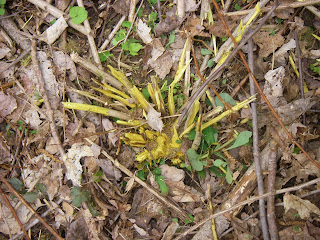 |
| Japanese Barberry is a highly invasive shrub that forms dense stands under forest canopies. |
 |
Gasoline powered weed whackers with brush blades are used to cut
Japanese Barberry when growing densely under a forest canopy. |
 |
| Skilled hands and tough equipment turn an invasive shrub into a pile of mulch. |
A cooperative investigation between
CT Agriculture Experiment Station and
UCONN Cooperative Extension is demonstrating the methods and materials of controlling Japanese Barberry in forested ecosystems. The use of mechanical, chemical, and direct burning has proven an effective strategy at controlling this highly invasive plant. The investigators are treating a 2-acre stand on Wheeler Hill and will be facilitating workshops for land managers and owners so that they can use the same methods for controlling Japanese Barberry on their own properties. This project is lead by
Jeffrey Ward,
Scott Williams,
J. P. Barsky of the CAES and
Thomas Worthley of UCONN Cooperative Extension. For more information about this project and to view a series of videos
click here.




No comments:
Post a Comment